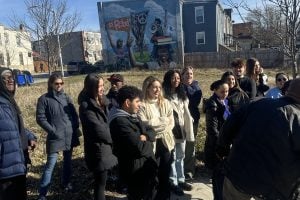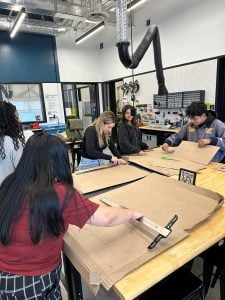
Throughout the academic year, undergraduate students in Center for Leadership Education courses have designed products and systems focused on improving the health and well-being of Baltimore City residents. Their designs have been adopted by several organizations around the city, including Baltimore City Public Schools, Bmore Community Food, and the Enoch Pratt Free Library system.
Locating harm reduction resources with CareLink
In 2022, the sophomore class of James A. Clark Scholars began researching issues impacting Baltimore residents in the CLE course Clark Scholar Engineering Design II. Among the numerous challenges identified by the scholars, opioid addiction stood out as a pressing issue on which they believed they could make the greatest impact.
“Baltimore City offers a wide variety of [opioid] harm reduction resources through local or state government and non-profit organizations, but information on these resources is difficult to access and often out of date,” said Mariah Snelson, Engr ’24.
Through their research, the students discovered a number of needle exchange programs, as well as those that distribute fentanyl test strips, safe injection kits, and naloxone, a medication used to rapidly reverse opioid overdoses. But they also noticed that many healthcare providers and rehabilitation facilities struggled to provide the public with current information on these programs.
The students set out to improve both the cataloging and distribution of information on existing harm reduction resources for public use. With feedback from managers of various resource centers, directors of the Baltimore City Health Department, peer navigators at multiple library branches across Baltimore City, and the student organization Hop-On Harm Reduction, they are building CareLink, a web-hosted database and website that provides a list of these resources, searchable by location, as well as an offline component.
“Many people who are looking for harm reduction resources in the city do not have adequate access to technology and primarily get their information through word of mouth and flyers. The website also generates location-based flyers that can be easily printed and distributed for those without easy access to or literacy for internet-based resources, a design requirement that grew out of interviews with community members,” said Bharath Heggadahalli, Engr ’24.
According to Evan Kuo, Engr ’24, collaborating with community partners on this project taught the students more than just how to devise solutions toward solving this problem.
“It’s been a very special opportunity to talk to people who have put so much passion and energy into helping others, and it’s given us a lot of motivation to try and amplify their voices and efforts as much as possible. I’ve learned that each person’s path to recovery can be very different and how important it is to meet people exactly where they are and to treat them with empathy,” Kuo said.
The scholars, who recently graduated, are working to finalize their database and website, which they hope will be an easily sustainable system that aggregates and updates information on available harm reduction resources. They have offered to stay on as advisors, with Kuo planning to continue with the project full-time. The team has also identified three undergraduates who are going to keep the project alive at Hopkins.
Trevor Mackesey, the team’s faculty advisor, says he has been encouraged both by the student’s successes and the commitment from stakeholders across the city. “Throughout the project, it has been inspiring to see the level of commitment in Baltimore City to helping people address opioid addiction. And through its pilot program, CareLink has already connected verified, local harm reduction resources to community members who need them. If the team can continue to build partnerships and awareness, CareLink is not just an answer to a systems engineering problem, it is a bridge to resources that save lives, Mackesey said.
Automated food delivery system to combat food insecurity
As a Center for Social Concern faculty fellow, Nusaybah Abu-Mulaweh, a lecturer in CLE, brought a collaboration with Bmore Community Food to her course Social Impact Design, co-taught with Senior Lecturer Alissa Burkholder Murphy, this spring. Through the project, their students were tasked with developing a meaningful solution to address food insecurity in Baltimore.
Before the students set about designing their food delivery system, the founder of Bmore Community Food, J.C. Faulk, spent time educating them about food insecurity, redlining, and low-income and low-access areas in the city. Faulk arranged site visits to affected neighborhoods, like Sandtown, where they spoke to residents about the food-related issues they faced. The students also volunteered at Bmore Community Food’s warehouse.
“It was one of the most wonderful experiences. If you’re an engineer designing a solution to a problem, most of the time, you’ve never seen the problem, and you’ve never seen the current state of the solution. When we volunteered, we got to do that. There was so much innovation and entrepreneurship going on in that warehouse. They were hacking air conditioning units to make refrigerators. They were being so resourceful,” said Ryan Alezz, a junior majoring in chemical and biomolecular engineering.
Faulk wanted to expand the reach of Bmore Community Food by replicating its warehouse on a smaller scale at multiple locations around Baltimore, using shipping containers as sites for the distribution of nonperishable food. He asked the team of Clark Scholars to design an automated conveyor mechanism that would fit inside each shipping container and distribute a box of food to each user who placed an order with Bmore Community Food. Constraints the team faced included a lack of space and power, as the shipping container could only be supported by a generator producing 120 volts of electricity.
warehouse on a smaller scale at multiple locations around Baltimore, using shipping containers as sites for the distribution of nonperishable food. He asked the team of Clark Scholars to design an automated conveyor mechanism that would fit inside each shipping container and distribute a box of food to each user who placed an order with Bmore Community Food. Constraints the team faced included a lack of space and power, as the shipping container could only be supported by a generator producing 120 volts of electricity.
The team was also concerned that the system might take up too much space in the shipping container, limiting room for an adequate number of food boxes to serve the community.
“We ended up figuring out some rollers and some conveyors that only utilize gravity instead of power. We had small power solutions here and there, like cameras and modules that stop the boxes, but it really made us think outside the box to try to figure out the system that didn’t use power. It still fits a fair amount of boxes. I think we calculated it to about 91 boxes in a small shipping container,” Alezz said.
According to Abu-Mulaweh, the students have made progress on the project very quickly, which she attributes in part to their varied engineering backgrounds.
“The synergy in class while designing and collaborating with the community partner and students from different engineering disciplines (MechE, ChemBE, Systems, and General Engineering) has been amazing and has brought together a range of skills and perspectives. We’ve also made some good progress on the project and are on track to provide an optimal design recommendation for the system and a proof of concept to the community partner by the end of the semester,” she said.
Indoor Gardens in Baltimore Public City Schools
In the course Multidisciplinary Engineering Design, an interdisciplinary team of engineering students worked with the City’s Farm to School program to bring indoor planting to Baltimore classrooms. Farm to School promotes experiential education in Baltimore City Public Schools, connecting students to nature and food systems in the classroom.
The team decided to focus on an indoor growing system for basil “because [they] wanted students to see how the food system works and have the experience of tasting the plant,” said Victoria George, a junior majoring in chemical and biomolecular engineering. Through this experience, students could observe sprouting within seven to 10 days and harvest within six to eight weeks.
After speaking with BPCS teachers and education professionals and researching existing indoor growing systems, the team decided on a wick hydroponic system.
“It’s a self-watering system in which the water is drawn upward through the wick, so it is low maintenance for the teachers and the students,” said Cameron Lee, Engr ’24.
The kit they created includes soil, seeds, wicks, a grow light timed to turn on or off every 12 hours, an instruction manual, and learning materials such as experiments and worksheets, making the process educational and easy for teachers to use. The team currently has four prototypes in BPCS classrooms.
“One teacher came back to us with some pictures of the class setting up the kit. We’re seeing them interact with the activities, and we were able to visit a class to see one of the prototypes in action,” said Joshua Montano, a senior majoring in chemical and biomolecular engineering.
For the team, this project was an opportunity to work with a client and see their prototypes in use.
“This class taught us how to start with user research, talking directly with teachers and childhood educators and then getting feedback from the students they teach. It’s something that I haven’t gotten a chance to do in any of my other classes or even outside of my classes. I’ve never worked on anything in my four years here, where I’ve done something this long-term for a class, and I think it’s really cool,” said Jam Navarro, Engr ’24.